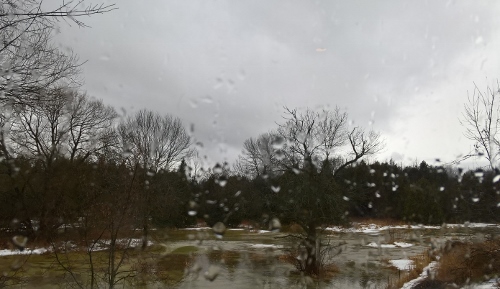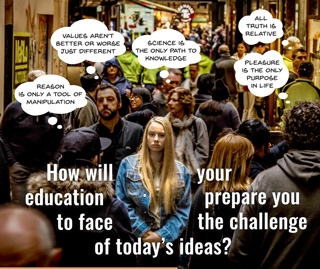
What a winter it’s been—snow, ice, two big thaws, and now almost spring, but with a veil of fresh snow. Weather is such a changing thing. One day I watched fluffy clouds race through a ‘peaceful’ blue sky and was astonished at how turbulent they were. In the space of time it took each cloud to cross my window-view, it had completely changed shape and had often been torn apart into wisps that formed into other clouds. Truly, there is so much going on that we are usually not even aware of.
That is good to remember when things are rough. I had been slowly regaining strength and then, foolishly, forgot to be disciplined about my limits, not once but several times. So I have been back on the couch, resting. We have a good couch, close to the fire, with a beautiful view of outside and with lovely flowers all around, so there is much to be thankful for but I also find it helpful to remember that “God moves in a mysterious way His wonders to perform.”
On the positive side, Miss 15 is finally officially concussion-free. To top that off, her pain issues seem to approaching a treatable diagnosis. Other family members are also feeling better and I dream of the day when we will no longer need any specialists, like the ‘good old days’ when we would only see our family doctor every year or two. Health is such a blessing, and seeing it come back is such a joy!
We have been playing Wordament in the evenings, a group of us in the living room near the fire, all busy finding words on our phones, discussing them and our scores, and then trying again. We have also started enjoying Scrabble, but lately that takes more energy than I can spare.
High School at Home
My usual weekly goal for homeschooling these past two months has been to do every day’s work every day, even if there are obstacles. It’s such an obvious goal but sometimes one just needs to be reminded of it, and the reminders help.
Miss 17 was considering BJUP’s American Lit course, which we were going to tweak to add a Canadian component. But when she discovered that it said the US had won the War of 1812, that was the end of that book. We looked at BJUP British Lit but rather than using its Beowulf study (only excerpts, not the complete work) we switched to Omnibus and the powerful Seamus Heaney translation of Beowulf. We both love reading that version of the poem and are really enjoying studying it. Most likely we will put together a British Lit course based on Omnibus, using the BJUP text only for a poetry unit.
After all sorts of setbacks, from illness to concussions and more, both our girls needed a solid and organized approach to math with the opportunity to regain lost time. So we switched to Saxon Math (from a mixture of Singapore’s New Elementary Math, Key To Algebra, and Key to Geometry) and it’s going well. The spiral approach effectively rebuilds confidence, the teaching is pedagogically sound, and the text is fuss-free. The only trouble is that one girl is focussing so heavily on math that the other one rarely has access to the text. So for her we are working on problem-solving using past issues of CEMC math competition papers, and a necessary review of arithmetic. The second textbook should arrive soon.
As for grammar, the Rod and Staff series was not a good fit for Miss 15, and we finally acknowledged that last summer. This year she’s been using Jensen’s Grammar and it seems to be working for her. I don’t like it, but she does and that’s what counts. The spiral approach is helping her, the short lessons are a benefit, and learning is happening.
Miss 17 is studying both Dutch and French and is doing well. We do mostly oral work in Dutch and a mixture of oral and written work in French. Although it has been difficult to work consistently on both of these every day, which is important for language learning, we are learning to juggle it despite a busy part time job.
Following Charlotte Mason’s idea of short lessons and a smorgasboard of learning, I have always preferred studying a bit of every subject every day throughout the year. However, now it seems to work better for my girls to focus on just one major subject at a time, and add only three or four other ones to their schedule.
As you have read, there have been a lot of changes in how we homeschool. Normally I prefer not to change curricula, especially in skill-based subjects like math, but so far it seems we have made the right switches. In the past it worked for our family to simply choose the best curriculum and method and just get to work, but now the SCRUM approach, being flexible and being more focused on goals than methods, seems more effective. (For more information, I recommend SCRUM: The Art of Doing Twice the Work in Half the Time by Jeff Sutherland especially pages 204-211 where the ideas are applied to education.)

Writing and Reading
In some sense, needing to rest so much for several months has allowed me to read and think more than usual. Here are some results of that:
“The Surprising Secrets of Highly Happy Marriages: What research and the Bible say about the best marriages,” a descriptive analysis of Shaunti Feldhahn’s book, The Surprising Secrets of Highly Happy Marriages, published in Reformed Perspective.
Worksheets Based on The Surprising Secrets of Highly Happy Marriages, available free right here on Tea Time with Annie Kate.
A review and outline of No Christian Silence on Science by Margaret Helder, published on The Curriculum Choice blog.
Reformed Perspective also republished a book review as “How does a Christian live in the midst of suffering? A book summary of Kelly Kapic’s Embodied Hope.” There are many important insights in the book including, “Being is pain is not a safe place to be alone. Lonely pain opens up temptations to despair, to dwelling on already-forgiven sins, and to questioning God’s care.” So, if people you know are in pain, reach out to them. Most likely you will best be able to reach out in little ways because they may not have energy for more; if you want guidance on how to help, read Embodied Hope as well as Side by Side and Being There (links are to my reviews).
I’ve also enjoyed reading or rereading:
Where We Belong by Lynn Austin, a thoughtful novel of adventure in the late 19th century.
The Code of Hammurabi, the first known set of laws, giving us a peek into Abraham’s world as well as a renewed appreciation for the fairness of God’s Old Testament laws. This was for homeschool and we used Omnibus 1 as a guide.
Free of Me by Sharon Hodde Miller, an analysis of the me-culture and our sinful self-centeredness.
The Happiness Project by Gretchin Rubin, because I am part of a Happiness Project group. This is basically about looking at what needs changing in our lives and exploring how to make that work, one monthly focus at a time.
No Christian Silence on Science by Margaret Helder, reread for the third time in order to review it.
The Surprising Secrets of Highly Happy Marriages by Shaunti Feldhahn, reread twice for the writing I was doing.
The Checklist Manifesto by Atul Gawande. The author correctly states that “the volume and complexity of what we know has exceeded our individual ability to deliver its benefits correctly, safely, or reliably.” Therefore “we need a different strategy for overcoming failure, one that build on experience and takes advantage of the knowledge people have but somehow also makes up for our inevitable human inadequacies….and there is such a strategy. It is a checklist.” I plan to write about this in the future.
Trading Secrets by Melody Carlson. Sometimes one needs a sunny, funny, wholesome book like this to lift one out of the doldrums.
Unstuffed by Ruth Soukup, a thoughtful look at why we stuff our homes, minds, and souls so full, what we can do about it, and what we don’t need to do. This book is, in many ways, a reflection of the Psalms that proclaim God’s praise for how he has saved, but it is also very practical in everyday terms. I will review it eventually.

Knowing God. I’ve managed the Bible reading and the prayer devotional, but have not been able to get outside every day, especially lately. Even so, just thinking about it has helped me keep my eyes open to what God is doing in creation.
Regaining health. Hah! But I’ve started reading a few books that may be helpful, will be meeting a new specialist in a few months, and am starting to deal with high heavy metal and low essential mineral levels. Since this month’s Happiness Project focus is health, I’ll have accountability to turn a few helpful practices into habits.
Loving my Family. Well, I love them and appreciate them more than ever, but most attempts at doing special things together has, so far, failed due to busyness and various health issues. But special outings are not what love is all about; prayer and everyday caring is.
Catching up. Some writing projects are caught up, but anything that requires physical effort is more behind than ever, including neatening my working space. Sigh. Some other things also, like speaking and lecturing, I have had to let go. Crossing them off my list was one way of getting them out of the way, I suppose, although it was hard. But I can only do what is possible and should not fret when my goals are obviously not in God’s plans right now.
So, those were some highlights of our past few months. Sometimes I feel like this is all just too much information, but other times I suspect that my friends are just like me, enjoying and learning from a peek into someone else’s life.
I hope that 2018 has started well for you and that you are able to realize, with me, that we have a lot to be thankful despite the negatives that we sometimes tend to focus on.
May God be gracious to us and bless us
and make his face to shine upon us,
that your way may be known on earth,
your saving power among all nations.
Psalm 67:1,2
—
If you enjoyed this article, you might want to follow me on Google+, where I often mention helpful or interesting ideas, friend me on Facebook where I am just a newbie, or connect with me on GoodReads where I, eventually, share what I read.






